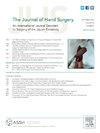桡骨纵向缺损对小儿拇指截骨术后长期使用拇指的影响
IF 2.1
2区 医学
Q2 ORTHOPEDICS
引用次数: 0
摘要
目的通过拇指抓捏(T-GAP)评价桡纵缺对指骨功能的影响。方法回顾性分析25例拇指发育不全患者行食指极化术。这些患者的平均随访时间为10.4年。双手按严重程度分为两组:无或轻度径向纵向缺陷(RLD)(组1 = 16)和中度至重度RLD(组2 = 9)。我们收集了人口统计信息并完成了体格检查,包括手的力量、肘部、腕部和手的活动范围、Kapandji反对得分、主动抓握广度和T-GAP总分。结果中重度RLD患者手指较长,Kapandji对立评分较低,肘关节屈曲、腕尺偏曲和拇指指间屈曲的主动和被动活动范围有限。他们的前臂较短,主动抓握范围较小,指间拇指关节处的拇指皱褶较少。此外,两组患者的T-GAP总分均显著低于对照组。轻度发育不良的儿童能够达到32%的年龄匹配的正常抓握力。与轻度发育不良的儿童相比,更严重的桡骨发育不良患者的抓握力平均减少17%。中度至重度RLD患者如果腕尺偏差有限,其T-GAP总分和力量测量值也较低。结论中重度RLD患者有其独特的解剖学因素影响分化后的预后。与患有轻度RLD的人相比,这些人使用拇指的活动较少,抓握能力较弱,并且保留了更原始的抓握模式。研究类型/证据水平本文章由计算机程序翻译,如有差异,请以英文原文为准。
The Effects of Radial Longitudinal Deficiency on Long-Term Use of the Thumb in Pediatric Patients Following Index Pollicization
Purpose
To assess the effect of radial longitudinal deficiency on the function of pollicized digits as determined by the Thumb Grasp and Pinch (T-GAP) assessment.
Methods
We retrospectively evaluated 25 hands with thumb hypoplasia that underwent index finger pollicization. Patients were followed for an average of 10.4 years. Hands were divided by severity into two groups: no or mild radial longitudinal deficiency (RLD) (Group 1 = 16) and moderate to severe RLD (Group 2 = 9). We collected demographic information and completed physical examination measures, including hand strength, elbow, wrist, and hand range of motion, the Kapandji opposition score, active grasp span, and T-GAP total score.
Results
Patients with moderate to severe forms of RLD had stiffer long fingers, lower Kapandji opposition scores, and limited active and passive range of motion for elbow flexion, wrist ulnar deviation, and pollicized thumb interphalangeal flexion. They had shorter forearms, decreased active grasp span, and fewer thumb creases at the interphalangeal thumb joint. In addition, the T-GAP total score was significantly lower when comparing the two groups. Children with mild dysplasia were able to achieve 32% of age-matched normal grasp strength. Patients with more severe radial dysplasia averaged 17% less grasp strength compared with children with mild dysplasia. Patients with moderate to severe RLD also had lower T-GAP total scores and strength measurements if they had limited wrist ulnar deviation.
Conclusions
Individuals with moderate to severe RLD have unique anatomical factors that affect outcomes after pollicization. These individuals use their thumbs for fewer activities, have weaker grasp, and retain more primitive grasp patterns compared with those who have milder forms of RLD.
Type of study/level of evidence
Prognostic IV.
求助全文
通过发布文献求助,成功后即可免费获取论文全文。
去求助
来源期刊
CiteScore
3.20
自引率
10.50%
发文量
402
审稿时长
12 weeks
期刊介绍:
The Journal of Hand Surgery publishes original, peer-reviewed articles related to the pathophysiology, diagnosis, and treatment of diseases and conditions of the upper extremity; these include both clinical and basic science studies, along with case reports. Special features include Review Articles (including Current Concepts and The Hand Surgery Landscape), Reviews of Books and Media, and Letters to the Editor.

 求助内容:
求助内容: 应助结果提醒方式:
应助结果提醒方式:


